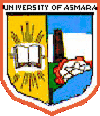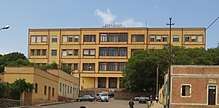University of Asmara
The University of Asmara (UoA) was a public university in Asmara, Eritrea. The nation's first university, it was founded in 1958 by the "Piae Madres Nigritiae" (Comboni Sisters). The school was meant to provide for the local population, though its initial enrollment in the 1950s was entirely Italian.[1]
 | |
| Type | Public |
|---|---|
| Established | 1958 |
| President | Tadesse Mehari |
| Location | , 15°20′33″N 38°55′39″E |
| Website | www |

History
| Wikisource has original text related to this article: |
The university was founded in 1958, albeit by a different name, the "Catholic College of Santa Famiglia".[2] Indeed in 1940 Dr. Vincenzo Di Meglio promoted the creation of the "School of Medicine" in Italian Asmara (the first university institution in Eritrea, located initially in the Liceo Martini), under the direction of Prof. Ferro Luzzi.[3] After WW2 this first university in Asmara was created with some of the teachers of the "School of Medicine".
..it is noteworthy to remember that the "University of Asmara" was created by Italian religious organizations. Indeed The University of Asmara (UoA) was the nation's first university, and was founded in 1958 by the 'Piae Madres Nigritiae' (Comboni Sisters). The school was meant to provide for the local population, though its initial enrollment in the 1950s was entirely Italian. The university was founded with the name "Collegio Cattolico della Santa Famiglia": the roots were in the 1941 "Scuola di Medicina", linked to the Asmara Hospital (then named "Regina Elena"). In the early years, the curriculum reflected Italian educational plans, and courses were taught in Italian with a view to preparing students to receive the "laurea" (degree) from a university in Italy. In 1958, members of the missionary congregation 'Piae Madres Nigritiae' or Comboni Sisters began private education classes for 10 Italian female students: the "Holy Family University Institute" was founded by the Italian Sister Marianora and Sister Fosca.B. D'Ambrosio[4]
By 1964, the university had been renamed and began offering Associate Diploma programs in the Arts, Commerce, and the Sciences.[1]
In 1979 the new president pushed through a major reorganization of the curriculum and structure. The next years saw an increase in students from 300 to 2,700. New courses, staff, day and evening extension programs and campus buildings revived the university, together with a bilateral agreement to exchange students and faculty with the University of Addis Ababa, particularly focusing on graduate training in Addis Ababa to produce faculty for Eritrea.[1] In the 1980s, the Arid Zone Agricultural College was established as a faculty.[5]
After Eritrean independence
The university stopped new student enrollments in 2003. In 2003, the government issued a directive re-configuring and prospective students (those who score a passing grade on the National High School Leaving Certificate Exam) are directed to one of five tertiary education institutions that opened after new admission to the university was stopped.
The Eritrea Institute of Technology is currently the biggest higher education institute in the country.
The Eritrean government's claim that the university was restructured and its resources reallocated to new institutions of higher education in order to grow student population is criticized by many. Critics claim the closing of the university was a political move aimed at increasing the government's control over college students.
References
- "University of Asmara: A Brief History". Retrieved 2006-09-02.
- Killion, Tom (1998). Historical Dictionary of Eritrea. The Scarecrow Press. ISBN 0-8108-3437-5.
- Nicky Di Paolo: "La Scuola di Medicina di Asmara" (in Italian)
- Italian schools & institutions in Asmara
- "General Information As of January 1, 2018". Mekelle University. Retrieved 6 October 2018.
Bibliography
- Feagles, Shelley M. A Guide to Educational Systems Around the World. Washington, D.C.: NAFSA, 1999.